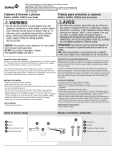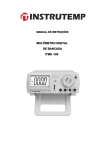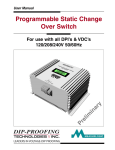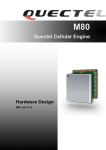Download FEB227 User's Guide Universal Input 12W LED Ballast
Transcript
www.fairchildsemi.com _______________________________________________________________________________________ FEB227 User’s Guide Universal Input 12W LED Ballast Featured Fairchild Product: FAN102MY © 2010 Fairchild Semiconductor Corporation Page 1 of 46 Rev 1.0, 12/2010 www.fairchildsemi.com _______________________________________________________________________________________ Table of Contents 1.0 General Board Description 4 1.1 Contents of the Evaluation Kit 4 1.2 Power Supply Specification Table 4 2.0 Circuit Description 5 2.1 Board Photograph 5 2.2 Schematic 7 2.3 PCB Layout 9 2.4 Evaluation Board Connection 10 3.0 Test Equipment 11 4.0 Test Results 12 4.1 Standby Power vs Input Voltage (Iout(max) = 350mA) 12 4.2 Full Load Efficieny vs Input Voltage (Iout(max) = 350mA) 14 4.3 Line Regulation (Iout(max) = 350mA) 15 4.4 Load Regulation (Iout(max) = 350mA) 16 4.5 Standby Power vs Input Voltage (Iout(max) = 700mA) 18 4.6 Full Load Efficieny vs Input Voltage (Iout(max) = 700mA) 20 4.7 Line Regulation (Iout(max) = 700mA) 21 4.8 Load Regulation (Iout(max) = 700mA) 22 4.9 Output Ripple & Noise 24 4.10 Soft Start Test 26 4.11 Output Short Circuit Protection Test 28 4.12 Typical Drain Waveforms 30 4.13 Thermal Performance 34 4.14 EMI Tests 36 5.0 Bill of Materials and Transformer Specification 38 5.1 Bill of Materials © 2010 Fairchild Semiconductor Corporation 38 Page 2 of 46 Rev 1.0, 12/2010 www.fairchildsemi.com _______________________________________________________________________________________ 5.2 Transformer Specification 39 6.0 Printed Circuit Board Special Instructions 40 7.0 Featured Products 42 7.1 FAN102 Description 42 7.1.1 FAN102 Features 42 7.1.2 FAN102 Block Diagram 43 8.0 References and Resources 44 8.1 Application Notes 44 Direct questions or comments about this Evaluation Board to: “Worldwide Direct Support” Fairchild Semiconductor.com © 2010 Fairchild Semiconductor Corporation Page 3 of 46 Rev 1.0, 12/2010 www.fairchildsemi.com _______________________________________________________________________________________ Disclaimer Fairchild Semiconductor Limited (“Fairchild”) provides these design services as a benefit to our customers. Fairchild has made a good faith attempt to build for the specifications provided or needed by the customer. Fairchild provides this product “as is” and without “recourse” and MAKES NO WARRANTY, EXPRESSED, IMPLIED OR OTHERWISE, INCLUDING ANY WARRANTY OF MERCHANTABILITY AND FITNESS FOR A PARTICULAR PURPOSE. Customer agrees to do its own testing of any Fairchild design in order to ensure design meets the customer needs. Neither Fairchild nor Customer shall be liable for incidental or consequential damages, including but not limited to, the cost of labor, re-qualifications, rework charges, delay, lost profits, or loss of goodwill arising out of the sale, installation or use of any Fairchild product. Fairchild will defend any suit or proceeding brought against Customer if it is based on a claim that any of its products infringes any U.S., Canadian, Japanese, EU or EFTA member country intellectual property right. Fairchild must be notified promptly in writing and given full and complete authority, information and assistance (at Fairchild’s expense) for defense of the suit. Fairchild will pay damages and costs therein awarded against Customer but shall not be responsible for any compromise made without its consent. In no event shall Fairchild’s liability for such damages and costs (including legal costs) exceed the contractual value of the goods or services that are the subject of the lawsuit. In providing such defense, or in the event that such product is held to constitute infringement and the use of the product is enjoined, Fairchild, in its discretion, shall procure the right to continue using such product, or modify it so that it becomes non-infringing, or remove it and grant Customer a credit for the depreciated value thereof. Fairchild’s indemnity does not extend to claims of infringement arising from Fairchild’s compliance with Buyer’s design, specifications and/or instructions, or use of any product in combination with other products or in connection with a manufacturing or other process. The foregoing remedy is exclusive and constitutes Fairchild’s sole obligation for any claim of intellectual property infringement. All solutions, designs, schematics, drawings, boards or other information provided by Fairchild to Customer are confidential and provided for Customer’s own use. Customer may not share any Fairchild materials with other semiconductor suppliers. For Fairchild Semiconductor Limited …………………………………. Name: …………………………. Date: ………………………….. Warning This Evaluation Board may employ high voltages so appropriate safety precautions should be used when operating this board. Replace components on the Evaluation Board only with those parts shown on the BOM. Contact an authorized Fairchild representative with any questions. © 2010 Fairchild Semiconductor Corporation Page 4 of 46 Rev 1.0, 12/2010 www.fairchildsemi.com _______________________________________________________________________________________ 1.0 General Board Description The FEB227 Evaluation Board is an isolated, primary-side regulated off-line AC/DC converter (power supply) in flyback technology. It has a universal input voltage range of 85VRMS to 265VRMS at a line frequency of 50Hz to 60Hz. It has one constant current output, selectable between 350mA and 700mA, both at a maximum output voltage of 17V. However the output current can easily be changed by changing one resistor. The controller used on the FEB227 Evaluation Board is Fairchild Semiconductor’s FAN102MY. This highly integrated PWM controller provides several features to enhance the performance of low-power flyback converters. The patented topology enables most simplified circuit design, especially for battery charger applications. The result is a low-cost, smaller and lighter charger when compared to a conventional design or a linear transformer. The start-up current is only 10uA, which allows use of large start-up resistance for further power saving. To minimize the standby power consumption, the proprietary green-mode function provides off-time modulation to linearly decrease PWM frequency under light-load conditions. This green-mode function assists the power supply to easily meet the power conservation requirement. By using FAN102, a charger can be implemented with fewest external components and a minimized cost. 1.1 Contents of the FEB227 Evaluation Kit 1.2 Power Supply Specification Table • FEB227 Evaluation Board • Data sheets for the parts listed below can be obtained on the Internet from Fairchild Semiconductor's website: http://www.fairchildsemi.com/ - FAN102MY - DF10S - RS1G/K - MM3Z24VB - ES3D - FCD4N60 - BC846B - Application Note: AN-6067 Minimum Line Voltage Maximum Line Voltage Line Frequency Output (selectable) © 2010 Fairchild Semiconductor Corporation 85VRMS 265VRMS 50Hz to 60Hz 350mA/700mAconstant current @ 17Vmax Page 5 of 46 Rev 1.0, 12/2010 www.fairchildsemi.com _______________________________________________________________________________________ 2.0 Circuit Description The input voltage is rectified and filtered by D101 and C102 to generate a DC voltage for the input of the flyback converter. Line filter LF101, X2 capacitor C101 and the X1/Y1 capacitor C1 act as an EMI filter. R101, C106 and D102 form a clamping network that limits the voltage spike due to the energy trapped in the leakage inductance of the transformer. After start-up R110/R112 are used to charge up C105. Once the threshold voltage is reached, IC101 is activated and draws its supply current from the Vcc winding (pins 4/5 of T1, rectified by D104). To keep the Vcc below a safe limit a simple linear regulator is used (C108, Q102, D105 and R111). The switching element Q101 is driven by the GATE pin via gate resistor R104. The output current level is determined by the current sense resistors R102 and R103. If J101 is open the current flows only through R102 and thus the output current is low. If J101 is shorted the current flows through the parallel connection of R102 and R103 and thus the output current is high. The voltage across R102/R103 is filtered by R105 and fed into the CS pin. The output voltage regulation is indirectly achieved by monitoring the Vcc level. To do this, Vcc is divided by R109 and R108 in order to get 2.5V at the voltage sense pin VS. C107 acts as a filter. The FAN102SZ has a built-in slope compensation. For frequency compensation R107/C103 are connected to the COMV pin and R106/C104 are connected to the COMI pin. The transformed voltage is rectified by D201 and filtered by the MLCC C201. 2.1 Board Photograph • Top Side View © 2010 Fairchild Semiconductor Corporation Page 6 of 46 Rev 1.0, 12/2010 www.fairchildsemi.com _______________________________________________________________________________________ • Bottom Side View © 2010 Fairchild Semiconductor Corporation Page 7 of 46 Rev 1.0, 12/2010 www.fairchildsemi.com _______________________________________________________________________________________ 2.2 Schematic 2.2.1. Power Supply Unit Section © 2010 Fairchild Semiconductor Corporation Page 8 of 46 Rev 1.0, 12/2010 www.fairchildsemi.com _______________________________________________________________________________________ 2.2.2. LED Section The heatsinks are optional and have not been assembled Iout HS202 HS_FISCHER_FK_250_06 HS204 HS_FISCHER_FK_250_06 HS206 HS_FISCHER_FK_250_06 LED201 XREWHT-L1-000-006E5 LED202 XREWHT-L1-0000-006E5 LED203 XREWHT-L1-0000-006E5 HS201 HS_FISCHER_FK_250_06 HS203 HS_FISCHER_FK_250_06 HS205 HS_FISCHER_FK_250_06 GND © 2010 Fairchild Semiconductor Corporation Page 9 of 46 Rev 1.0, 12/2010 www.fairchildsemi.com _______________________________________________________________________________________ 2.3 PCB Layout • Top Side View • Bottom Side View NB: Component D103 is not being assembled © 2010 Fairchild Semiconductor Corporation Page 10 of 46 Rev 1.0, 12/2010 www.fairchildsemi.com _______________________________________________________________________________________ 2.4 Evaluation Board Connection Important note: Do not connect anything to CONN201 while operated with the on-board LEDs! Warning: The circuit is line connected and contains high voltages. Caution and proper procedures should be observed when using and making measurements on the board. © 2010 Fairchild Semiconductor Corporation Page 11 of 46 Rev 1.0, 12/2010 www.fairchildsemi.com _______________________________________________________________________________________ 3.0 Test Equipment • Oscilloscope: • • • • • • TEKTRONIX TDS784C (1GHz / 4GS/s) using voltage probes P5100, P6139A and current probe TCP202. Analyzer: TEKTRONIX 2712 Multimeter: RMS MULTIMETER FLUKE 85 II Electronic Load: Prodigit 3000C Base unit using 3311C, 3314C and 2x 3332A modules Power Analyzer: LEM NORMA 5000 AC Source: Chroma Programmable AC Source Model 61502 Temp. Probe: Greisinger dual channel digital thermometer GMH3230 using two GTF300 NiCr-Ni thermocouples The ambient temperature for all tests was 25 ºC if not noted otherwise © 2010 Fairchild Semiconductor Corporation Page 12 of 46 Rev 1.0, 12/2010 www.fairchildsemi.com _______________________________________________________________________________________ 4.0 Test Results 4.1 Standby Power vs Input Voltage (Iout(max) = 350mA) 4.1.1 Test Condition and Method The input power for various input voltages was measured at no load and at minimum load (i.e. at Vout(min)). The standby power was calculated as PStdby = PIN – POUT. At minimum load the output current was measured and the minimum and maximum deviation from the nominal output current calculated. 4.1.2 No Load Standby Power 85 0.30 Standby Power [W] VIN [VRMS] PSTDBY [W] 110 0.31 130 0.32 150 0.34 180 0.37 210 0.41 230 0.43 240 0.44 265 0.46 0.50 0.40 0.30 0.20 0.10 80 110 140 170 200 230 260 Input Voltage [V RMS ] 4.1.3 Accuracy of Output with No Load VIN [VRMS] Vout [V] 85 30.00 110 31.00 130 32.00 © 2010 Fairchild Semiconductor Corporation 150 32.00 180 33.00 210 34.00 230 35.00 Page 13 of 46 240 36.00 265 33.00 Rev 1.0, 12/2010 www.fairchildsemi.com _______________________________________________________________________________________ 4.1.4 Minimum Load Standby Power 85 0.41 Standby Power [W] VIN [VRMS] PSTDBY [W] 110 0.44 130 0.49 150 0.51 180 0.57 210 0.65 230 0.71 240 0.75 265 0.78 0.90 0.70 0.50 0.30 0.10 80 110 140 170 200 230 260 Input Voltage [V RMS ] 4.1.5 Output Current at Minimum Load VIN [VRMS] VOUT [V] IOUT [mA] 85 2.8 341 110 2.8 344 130 2.8 351 150 2.8 357 © 2010 Fairchild Semiconductor Corporation 180 2.8 354 210 2.8 357 230 2.8 368 240 2.8 375 Page 14 of 46 265 2.8 342 Min [%] -2.6 Max [%] 7.1 Rev 1.0, 12/2010 www.fairchildsemi.com _______________________________________________________________________________________ 4.2 Full Load Efficiency vs Input Voltage (Iout(max) = 350mA) 4.2.1 Test Condition and Method The power supply was set up with its output loaded at maximum load. The input voltage was swept across the specified range. The output load was kept constant. The input power was measured and efficiency calculated. 4.2.2 Result 85 5.20 6.63 78.38 Efficiency [%] VIN [VRMS] POUT [W] PIN [W] Efficiency [%] 110 5.24 6.64 78.95 130 5.27 6.70 78.70 150 5.30 6.73 78.68 180 5.33 6.81 78.21 210 5.36 6.91 77.51 230 5.37 6.98 76.98 240 5.38 7.01 76.79 265 5.36 7.03 76.31 79.5 79.0 78.5 78.0 77.5 77.0 76.5 76.0 80 110 140 170 200 230 260 Input Voltage [V RMS ] © 2010 Fairchild Semiconductor Corporation Page 15 of 46 Rev 1.0, 12/2010 www.fairchildsemi.com _______________________________________________________________________________________ 4.3 Line Regulation (Iout(max) = 350mA) 4.3.1 Test Condition and Method The power supply was set up with its output loaded at maximum load. The input voltage was swept across its specified range. Output current was measured for each input voltage and was displayed relative to the nominal output current. The nominal current in this case is the current measured for the output at VIN = 230VRMS. 4.3.2 Result Regulation [% of nominal] The minimum and maximum values in the table below are calculated as deviations from the output voltage as specified in section 1.2. 85 110 130 150 180 210 230 240 265 Min [%] Max [%] VIN [VRMS] 305.40 308.20 310.00 311.30 313.10 314.90 315.90 316.50 315.20 -12.7 -9.6 IOUT [mA] 101.0 100.0 99.0 98.0 97.0 96.0 95.0 80 110 140 170 200 230 260 Input Voltage [V RMS ] © 2010 Fairchild Semiconductor Corporation Page 16 of 46 Rev 1.0, 12/2010 www.fairchildsemi.com _______________________________________________________________________________________ 4.4 Load Regulation (Iout(max) = 350mA) 4.4.1 Test Condition and Method The load voltage of the output is swept from 2.0V to 19V and the output current is being measured. These measurements are done with 110VRMS and 230VRMS input voltage. 4.4.2 Result for Vin = 110VRMS 2.00 325.00 2.25 336.00 2.50 343.00 2.80 345.60 4.38 343.80 5.96 340.00 7.53 336.00 Vout [V] Iout [mA] 9.11 333.40 10.69 327.00 12.27 322.00 13.84 317.00 15.42 312.60 17.00 308.30 17.25 307.60 Vout [V] Iout [mA] 17.50 305.90 17.75 271.00 18.00 230.40 18.25 183.80 18.50 142.80 18.75 105.00 19.00 70.80 Vout [V] Vout [V] Iout [mA] 20.0 16.0 12.0 8.0 4.0 0.0 0.0 50.0 100.0 150.0 200.0 250.0 300.0 350.0 400.0 Iout [m A] © 2010 Fairchild Semiconductor Corporation Page 17 of 46 Rev 1.0, 12/2010 www.fairchildsemi.com _______________________________________________________________________________________ 4.4.3 Result for Vin = 230VRMS 2.00 361.60 2.25 371.10 2.50 360.00 2.80 365.00 4.38 336.00 5.96 340.00 7.53 341.30 Vout [V] Iout [mA] 9.11 347.00 10.69 336.80 12.27 331.00 13.84 323.00 15.42 320.60 17.00 316.00 17.25 315.10 Vout [V] Iout [mA] 17.50 314.40 17.75 313.80 18.00 307.90 18.25 250.10 18.50 193.20 18.75 145.20 19.00 98.80 Vout [V] Vout [V] Iout [mA] 20.0 16.0 12.0 8.0 4.0 0.0 0.0 50.0 100.0 150.0 200.0 250.0 300.0 350.0 400.0 Iout [m A] © 2010 Fairchild Semiconductor Corporation Page 18 of 46 Rev 1.0, 12/2010 www.fairchildsemi.com _______________________________________________________________________________________ 4.5 Standby Power vs Input Voltage (Iout(max) = 700mA) 4.5.1 Test Condition and Method The input power for various input voltages was measured at no load and at minimum load (i.e. at Vout(min)). The standby power was calculated as PStdby = PIN – POUT. At minimum load the output current was measured and the minimum and maximum deviation from the nominal output current calculated. 4.5.2 No Load Standby Power 85 0.41 Standby Power [W] VIN [VRMS] PSTDBY [W] 110 0.48 130 0.49 150 0.50 180 0.51 210 0.55 230 0.61 240 0.62 265 0.64 0.70 0.60 0.50 0.40 0.30 0.20 0.10 80 110 140 170 200 230 260 Input Voltage [V RMS ] 4.5.3 Accuracy of Output with No Load VIN [VRMS] Vout [V] 85 38.5 110 42.4 130 45.0 © 2010 Fairchild Semiconductor Corporation 150 46.0 180 46.0 210 49.0 230 49.0 Page 19 of 46 240 49.0 265 50.0 Rev 1.0, 12/2010 www.fairchildsemi.com _______________________________________________________________________________________ 4.5.4 Minimum Load Standby Power 85 0.64 Standby Power [W] VIN [VRMS] PSTDBY [W] 110 0.67 130 0.71 150 0.76 180 0.82 210 0.89 230 0.94 240 0.96 265 1.04 1.20 1.00 0.80 0.60 0.40 0.20 0.00 80 110 140 170 200 230 260 Input Voltage [Vrm s] 4.5.5 Output Current at Minimum Load VIN [VRMS] VOUT [V] IOUT [mA] 85 2.8 536 110 2.8 555 130 2.8 566 150 2.8 576 © 2010 Fairchild Semiconductor Corporation 180 2.8 589 210 2.8 599 230 2.8 602 240 2.8 603 Page 20 of 46 265 2.8 606 Min [%] -23.4 Max [%] -13.4 Rev 1.0, 12/2010 www.fairchildsemi.com _______________________________________________________________________________________ 4.6 Full Load Efficiency vs Input Voltage (Iout(max) = 700mA) 4.6.1 Test Condition and Method The power supply was set up with its output loaded at maximum load. The input voltage was swept across the specified range. The output load was kept constant. The input power was measured and efficiency calculated. 4.6.2 Result 85 10.20 12.58 81.08 Efficiency [%] VIN [VRMS] POUT [W] PIN [W] Efficiency [%] 110 10.90 13.21 82.51 130 10.94 13.23 82.69 150 10.97 13.22 82.98 180 11.05 13.38 82.59 210 11.10 13.45 82.53 230 11.12 13.50 82.37 240 11.14 13.54 82.27 265 11.18 13.64 81.96 83.5 83.0 82.5 82.0 81.5 81.0 80.5 80 110 140 170 200 230 260 Input Voltage [V RMS ] © 2010 Fairchild Semiconductor Corporation Page 21 of 46 Rev 1.0, 12/2010 www.fairchildsemi.com _______________________________________________________________________________________ 4.7 Line Regulation (Iout(max) = 700mA) 4.7.1 Test Condition and Method The power supply was set up with its output loaded at maximum load. The input voltage was swept across its specified range. Output current was measured for each input voltage and was displayed relative to the nominal output current. The nominal current in this case is the current measured for the output at VIN = 230VRMS. 4.7.2 Result Regulation [% of nominal] The minimum and maximum values in the table below are calculated as deviations from the output voltage as specified in section 1.2. 85 110 130 150 180 210 230 240 265 Min [%] Max [%] VIN [VRMS] 599.70 640.00 643.00 645.00 649.70 652.40 654.00 654.80 657.00 -14.3 -6.1 IOUT [mA] 102.0 100.0 98.0 96.0 94.0 92.0 90.0 80 110 140 170 200 230 260 Input Voltage [V RMS ] © 2010 Fairchild Semiconductor Corporation Page 22 of 46 Rev 1.0, 12/2010 www.fairchildsemi.com _______________________________________________________________________________________ 4.8 Load Regulation (Iout(max) = 700mA) 4.8.1 Test Condition and Method The load voltage of the output is swept from 2.0V to 19V and the output current is being measured. These measurements are done with 110VRMS and 230VRMS input voltage. 4.8.2 Result for Vin = 110VRMS 2.00 510.00 2.25 527.00 2.50 541.00 2.80 555.50 4.38 616.00 5.96 654.10 7.53 675.00 Vout [V] Iout [mA] 9.11 677.80 10.69 670.00 12.27 663.00 13.84 655.70 15.42 648.20 17.00 640.20 17.25 638.60 Vout [V] Iout [mA] 17.50 637.00 17.75 630.50 18.00 543.00 18.25 431.60 18.50 332.00 18.75 243.00 19.00 167.00 Vout [V] Vout [V] Iout [mA] 20.0 16.0 12.0 8.0 4.0 0.0 0.0 80.0 160.0 240.0 320.0 400.0 480.0 560.0 640.0 720.0 Iout [m A] © 2010 Fairchild Semiconductor Corporation Page 23 of 46 Rev 1.0, 12/2010 www.fairchildsemi.com _______________________________________________________________________________________ 4.8.3 Result for Vin = 230VRMS 2.00 545.00 2.25 569.00 2.50 591.00 2.80 603.00 4.38 684.50 5.96 706.00 7.53 700.00 Vout [V] Iout [mA] 9.11 692.00 10.69 683.80 12.27 676.50 13.84 669.00 15.42 662.00 17.00 654.40 17.25 653.10 Vout [V] Iout [mA] 17.50 651.80 17.75 648.10 18.00 625.50 18.25 585.00 18.50 442.00 18.75 322.00 19.00 217.00 Vout [V] Vout [V] Iout [mA] 20.0 16.0 12.0 8.0 4.0 0.0 0.0 80.0 160.0 240.0 320.0 400.0 480.0 560.0 640.0 720.0 Iout [m A] © 2010 Fairchild Semiconductor Corporation Page 24 of 46 Rev 1.0, 12/2010 www.fairchildsemi.com _______________________________________________________________________________________ 4.9 Output Ripple & Noise 4.9.1 Test condition and Method for Voltage Ripple and Noise The output was loaded with the maximum load. The so-called PARD (periodic and random disturbance) method was used to measure ripple and noise voltage in AC coupling mode. See for example Celestica application note AN-1259-1-R2. IMPORTANT NOTE: Output voltage ripple measurements cannot be made using a normal oscilloscope probe set-up. Magnetic field coupling into the ground connection for the oscilloscope probe could cause noise voltages far greater than the true ripple voltage. The test was done with Iout(max) = 350mA and Iout(max) = 700mA respectively. A VIN of 110VRMS and 230VRMS was used. 4.9.2 Result for Iout(max) = 350mA Vin = 110VRMS Vin = 230VRMS Ch2: VRipple @ 200mV/div, time-base @ 5ms/div, V-Ripplep-p: 820mV Ch2: VRipple @ 200mV/div, time-base @ 5ms/div, V-Ripplep-p: 592mV 4.9.3 Result for Iout(max) = 700mA Vin = 110VRMS Vin = 230VRMS Ch2: VRipple @ 500mV/div, time-base @ 5ms/div, V-Ripplep-p: 1.7V Ch2: VRipple @ 200mV/div, time-base @ 5ms/div, V-Ripplep-p: 1.06V © 2010 Fairchild Semiconductor Corporation Page 25 of 46 Rev 1.0, 12/2010 www.fairchildsemi.com _______________________________________________________________________________________ 4.9.4 Test condition and Method for Current Ripple The output was loaded with the maximum load. Using a current probe as mentioned in section 3.0. the output current was traced. The test was done with Iout(max) = 350mA and Iout(max) = 700mA respectively. A VIN of 110VRMS and 230VRMS was used. 4.9.5 Result for Iout(max) = 350mA Vin = 110VRMS Vin = 230VRMS Ch4: Iout @ 100mA/div, time-base @ 5ms/div, I-Ripplep-p: 140mA Ch4: Iout @ 50mA/div, time-base @ 5ms/div, I-Ripplep-p: 101mA 4.9.6 Result for Iout(max) = 700mA Vin = 110VRMS Vin = 230VRMS Ch4: Iout @ 200mA/div, time-base @ 5ms/div, I-Ripplep-p: 308mA Ch4: Iout @ 100mA/div, time-base @ 5ms/div, I-Ripplep-p: 188mA © 2010 Fairchild Semiconductor Corporation Page 26 of 46 Rev 1.0, 12/2010 www.fairchildsemi.com _______________________________________________________________________________________ 4.10 Soft Start Test 4.10.1 Test Condition and Method The output was loaded with the maximum load. The voltage on the output as well as the drain voltage and drain current of Q101 were measured during a power up sequence. The test was done with Iout(max) = 350mA and Iout(max) = 700mA respectively. A VIN of 110VRMS and 230VRMS was used. 4.10.2 Result for Iout(max) = 350mA @ VIN = 110VRMS Output Voltage Ch2: VOUT @ 5V/div, time-base @ 4ms/div Ch1: VDrain @ 100V/div, Ch4: IDrain @ 200mA/div, time-base @ 5ms/div, VDrain(max) = 320V 4.10.3 Result for Iout(max) = 350mA @ VIN = 230VRMS Output Voltage Ch2: VOUT @ 5V/div, time-base @ 4ms/div © 2010 Fairchild Semiconductor Corporation Drain Voltage and Drain Current Drain Voltage and Drain Current Ch1: VDrain @ 200V/div, Ch4: IDrain @ 200mA/div, time-base @ 5ms/div, VDrain(max) = 504V Page 27 of 46 Rev 1.0, 12/2010 www.fairchildsemi.com _______________________________________________________________________________________ 4.10.4 Result for Iout(max) = 700mA @ VIN = 110VRMS Output Voltage Ch2: VOUT @ 5V/div, time-base @ 4ms/div Ch1: VDrain @ 100V/div, Ch4: IDrain @ 200mA/div, time-base @ 5ms/div, VDrain(max) = 336V 4.10.5 Result for Iout(max) = 700mA @ VIN = 230VRMS Output Voltage Ch2: VOUT @ 5V/div, time-base @ 4ms/div © 2010 Fairchild Semiconductor Corporation Drain Voltage and Drain Current Drain Voltage and Drain Current Ch1: VDrain @ 200V/div, Ch4: IDrain @ 200mA/div, time-base @ 5ms/div, VDrain(max) = 520V Page 28 of 46 Rev 1.0, 12/2010 www.fairchildsemi.com _______________________________________________________________________________________ 4.11 Output Short Circuit Protection Test 4.11.1 Test Condition and Method The output was shorted. The voltages on the Vcc, CS, COMI and COMV pins were measured with an input voltage of VIN = 265VRMS. 4.11.2 Result for Vcc and CS pin Ch2: Vcc @ 5V/div, Ch3: CS pin @ 100mV/div, time-base @ 100ms/div © 2010 Fairchild Semiconductor Corporation Page 29 of 46 Rev 1.0, 12/2010 www.fairchildsemi.com _______________________________________________________________________________________ 4.11.3 Result for COMI and COMV pin Ch2: COMI pin @ 1V/div, Ch3: COMV pin @ 1V/div, time-base @ 40ms/div © 2010 Fairchild Semiconductor Corporation Page 30 of 46 Rev 1.0, 12/2010 www.fairchildsemi.com _______________________________________________________________________________________ 4.12 Typical Drain Waveforms 4.12.1 Test Condition and Method The output was loaded with maximum load. The drain voltage and drain current of Q101 were measured. The test was done with Iout(max) = 350mA and Iout(max) = 700mA respectively. A VIN of 110VRMS and 230VRMS was used. 4.12.2 Result for Iout(max) = 350mA @ Vin = 110VRMS Ch1: VDrain @ 100V/div, Ch4: IDrain @ 200mA/div, time-base @ 10µs/div © 2010 Fairchild Semiconductor Corporation Page 31 of 46 Rev 1.0, 12/2010 www.fairchildsemi.com _______________________________________________________________________________________ 4.12.3 Result for Iout(max) = 350mA @ Vin = 230VRMS Ch1: VDrain @ 200V/div, Ch4: IDrain @ 200mA/div, time-base @ 10µs/div © 2010 Fairchild Semiconductor Corporation Page 32 of 46 Rev 1.0, 12/2010 www.fairchildsemi.com _______________________________________________________________________________________ 4.12.4 Result for Iout(max) = 700mA @ Vin = 110VRMS Ch1: VDrain @ 100V/div, Ch4: IDrain @ 200mA/div, time-base @ 10µs/div © 2010 Fairchild Semiconductor Corporation Page 33 of 46 Rev 1.0, 12/2010 www.fairchildsemi.com _______________________________________________________________________________________ 4.12.5 Result for Iout(max) = 700mA @ Vin = 230VRMS Ch1: VDrain @ 200V/div, Ch4: IDrain @ 200mA/div, time-base @ 10µs/div © 2010 Fairchild Semiconductor Corporation Page 34 of 46 Rev 1.0, 12/2010 www.fairchildsemi.com _______________________________________________________________________________________ 4.13 Thermal Performance 4.13.1 Test Condition and Method The temperatures of the transformer (T1), controller (IC101), MOSFET (Q101) and the secondary rectifying diode (D201) were measured with thermocouples. The measured temperatures were monitored from start up of the PSU until a steady state was recognized. The test was done with Iout(max) = 700mA/17V at VIN of 110VRMS and 230VRMS respectively. Tamb = 24°C. ϑ [°C] 4.13.2 Result for IC101 and T1 @ VIN = 110VRMS 60 50 40 30 20 IC101 10 T1 0 0 5 10 15 20 25 30 35 40 t [min] ϑ [°C] 4.13.3 Result for for Q101 and D201 @ VIN = 110VRMS 60 50 40 30 20 D201 10 Q101 0 0 5 10 15 20 25 30 35 40 t [min] © 2010 Fairchild Semiconductor Corporation Page 35 of 46 Rev 1.0, 12/2010 www.fairchildsemi.com _______________________________________________________________________________________ ϑ [°C] 4.13.4 Result for IC101 and T1 @ VIN = 230VRMS 60 50 40 30 20 IC101 10 T1 0 0 5 10 15 20 25 30 35 40 t [min] ϑ [°C] 4.13.5 Result for for Q101 and D201 @ VIN = 230VRMS 60 50 40 30 20 D201 10 Q101 0 0 5 10 15 20 25 30 35 40 t [min] © 2010 Fairchild Semiconductor Corporation Page 36 of 46 Rev 1.0, 12/2010 www.fairchildsemi.com _______________________________________________________________________________________ 4.14 EMI Tests 4.14.1 Test Condition The power supply was loaded with a resistor of 26.5Ω. The GND net of the output was connected to the PE conductor. Input voltages of 110VRMS and 230VRMS were used. The average level of the conducted EMI has been measured with the setup given in 3.0 and is compared to the Quasi-Peak and Average limits given by CISPR 22 (EN55022). 4.14.2 Result for VIN = 110VRMS © 2010 Fairchild Semiconductor Corporation Page 37 of 46 Rev 1.0, 12/2010 www.fairchildsemi.com _______________________________________________________________________________________ 4.14.3 Result for VIN = 230VRMS © 2010 Fairchild Semiconductor Corporation Page 38 of 46 Rev 1.0, 12/2010 www.fairchildsemi.com _______________________________________________________________________________________ 5.0 Bill of Materials and Transformer Specification 5.1 Bill of Materials Item 1 2 3 4 5 6 7 8 9 10 11 12 13 14 15 16 17 18 Quantity 1 1 1 1 1 2 1 1 1 1 1 1 1 1 1 1 1 1 Reference CONN101 CONN201 C1 C101 C102 C103, C108 C104 C105 C106 C107 C201 D101 D102 D103 (not assembled) D104 D105 D201 FS101 HS201, HS202, HS203, HS204, HS205, HS206 (not assembled) IC101 19 6 20 1 21 1 J101 Jumper 22 23 24 25 26 27 28 39 30 31 32 33 34 35 3 1 1 1 1 2 1 1 1 1 1 1 2 1 LED201, LED202, LED203 LF101 Q101 Q102 R101 R102, R103 R104 R105 R106 R107 R108 R109 R110, R112 R111 XREWHT-L1-0000-006E5 2x39mH / 0.6A FCD4N60 BC846B 100K / 2W / 5% 2R / 0.25W / 1% 10R / 0.063W / 1% 100R / 0.1W / 1% 200K / 0.1W / 1% 39K / 0.1W / 1% 7.5K / 0.1W / 1% 160K / 0.1W / 1% 750K / 0.25W / 1% 3K / 0.1W / 1% 36 1 T1 EF20/EF25 horizontal © 2010 Fairchild Semiconductor Corporation Part GMKDS1,5/2 MKDSN1,5/2 2.2nF / X1Y1 220nF / X2 22uF / 400V 10nF / 50V 68nF / 16V 10uF / 25V 10nF / 500V 68pF / 16V 22uF / 25V DF10S RS1K FDLL4148 RS1G MM3Z24VB ES3D 230V/250mA, time lag Comment Phoenix Contact, GMKDS 1,5 Phoenix Contact, MKDSN1,5 Murata, DE Epcos, B32922C Nichicon, VR any SMD 0603 any SMD 0603 any SMD 1206 any SMD 0805 any SMD 0603 Kemet, C2220C226K3RAC Fairchild Semiconductor Fairchild Semiconductor Fairchild Semiconductor Fairchild Semiconductor Fairchild Semiconductor Fairchild Semiconductor Littlefuse/Wickmann, TR5 Heatsink Fischer Elektronik, FK250 FAN102MY Fairchild Semiconductor 2-pin pin header, 100mil pitch plus shorting link Cree, XLamp XR-E Epcos, B82731-M Fairchild Semiconductor Fairchild Semiconductor Any KOA, SR732BTTD2R00F any SMD 0603 any SMD 0603 any SMD 0603 any SMD 0603 any SMD 0603 any SMD 0603 any SMD 1206 any SMD 0603 TDK, p/n SRW20EF-X46H014 or see transformer spec Page 39 of 46 Rev 1.0, 12/2010 www.fairchildsemi.com _______________________________________________________________________________________ 5.2 Transformer Specification 5.2.1 Winding Details Name Pins (Start →End) W1 3→1 W2 W3 5.2.2 Strands x Wire ø Turns Construction Material 2 1 x 0.20mm 100 perfect solenoid CuLL 9,10 → 6,7 2 2 x 0.40mm 15 bifilar triple insulated 4→5 1 1 x 0.15mm 39 spaced winding CuLL Electrical Characteristics Parameter Primary Inductance Leakage inductance 5.2.3 Specification 2.06mH +/- 5% 42uH maximum Conditions 100kHz, 1000mV, all secondaries open 100kHz, 1000mV, all secondaries short E20/10/6 (EF20) PC47, TDK or equivalent EF20 horizontal / 10 pins with extended creepage approx. 0.19mm for AL of 206nH/turns² Safety High voltage test: 5.2.5 Pins 1→3 1→3 Core and Bobbin Core Material Bobbin Gap in center leg 5.2.4 # of Layers 3000VRMS for 1 minute between primary (pins 1 to 5 ) and secondary (pins 6 to 10) Ordering A complete assembled transformer following this specification can be ordered directly from TDK, partnumber: SRW20EF-X46H014. © 2010 Fairchild Semiconductor Corporation Page 40 of 46 Rev 1.0, 12/2010 www.fairchildsemi.com _______________________________________________________________________________________ 6.0 Printed Circuit Board Special Instructions Important safety precautions: These boards are only to be operated and handled by qualified technicians and qualified engineers who have received a specific training on the handling of high voltage laboratory boards and equipment. DO NOT test the board without proper safety equipment, such as an isolation transformer, safety glasses and/or sun glasses. DO NOT allow people to look directly into the LED light. LEDs are bright enough to damage your eyesight if you look directly into the light. DO NOT allow people to touch any part of the board, both during operation and when the board is turned off. Disconnected boards can only be handled once they have cooled down and also someone has confirmed that all capacitors on the board have been fully discharged. Failure to follow these rules could result in electrical shock due to high voltages or burns due to hot parts. DO NOT test in proximity to flammable or explosive materials. DO NOT operate the board for extended periods at Iout = 700mA, or leave it unattended while operated. DO NOT install the board into any product. Operation of the board: 1. Read the safety precautions above first and follow all instructions thoroughly. 2. Make sure that jumper J101 is open, i.e. the two pins are not shorted. 3. Make sure that nothing is connected to output terminal CONN201. 4. Connect an isolated variable AC source (such as a variac) to input terminal CONN101 5. Slowly increase the AC input voltage from 0VAC to at least 85VAC (Do not exceed 265VAC). Do not allow people to look directly at the LEDs while doing so. 6. Confirm that the LEDs light up, however do not allow people to look directly at the LEDs. Caution: They already light up at approx. Vin = 48VAC. 7. After operation remove the AC input and confirm that the circuit is de-energized. Selecting the output current: The board is designed to deliver a constant output current of either 350mA or 700mA respectively. This is done by opening (Iout = 350mA) or closing/shorting (Iout = 700mA) jumper J101. During operation the LEDs get hot and you must not touch them. Due to the higher heat dissipation at Iout = 700mA it is not recommended to operate the board for an extended time in this mode. If desired, an isolated heatsink may be applied to the backside of the board, directly beneath the LEDs. Modification of the Board for other output currents: The output current of the circuit is determined by a current sense resistor that is connected from source of Q101 to GND. The relationship between the output current Io and the sense resistor RS is expressed as: RS = 0.111875 ⋅ np Io np is the ratio between the number of primary and secondary windings, np = For example, RS for an Iout of 100mA can be calculated as N pri . In this design np is 6.67. N sec 0.111875 ⋅ 6.67 = 7.46 . From an E96 series pick 7.5Ω. Leave jumper 0 .1 J101 open, remove R102 and R103 and replace R102 with a 7.5Ω resistor. Higher accuracy of the calculated resistor value can be © 2010 Fairchild Semiconductor Corporation Page 41 of 46 Rev 1.0, 12/2010 www.fairchildsemi.com _______________________________________________________________________________________ achieved by using two resistors in parallel. In that case replace R102 and R103 with the two resistors and close (short) jumper J101. Please note that the whole design and especially the transformer design was laid-out for Pout(max) = 12W. Therefore the maximum output current is 700mA. Important note: The same safety precautions as written above apply! Modification of the Board for stand alone operation: It is possible to test the board with your own LEDs or test the performance without the on-board LEDs. This can be done by cutting the board. First remove all cables and connections from the board and confirm that the circuit is de-energized. Then cut along the white line labeled ‘← Cut here for standalone operation’. After the PCB is cut into two pieces you can use CONN201 to connect your own application to the output. Input/output specifications remain the same. Important note: The same safety precautions as written above apply! Connect more LEDs to the output: Since this is a constant current output design you can drive one LED or up to six (or even more, depending on the forward voltage Vf of the LEDs). The maximum output voltage is 17V. So, if you connect 5 LEDs, the Vf(max) of one LED should not be higher than 3.4V (2.8V for six LEDs). To connect a given number of LEDs to the output, the board must be operated stand alone, ie physically remove the actual power supply from the on-board LEDs by cutting the board (see previous paragraph). Important note: The same safety precautions as written above apply! © 2010 Fairchild Semiconductor Corporation Page 42 of 46 Rev 1.0, 12/2010 www.fairchildsemi.com _______________________________________________________________________________________ 7.0 Featured Products 7.1 FAN102 Description The FAN102 is a highly integrated PWM controller provides several features to enhance the performance of low-power flyback converters. The patented topology enables most simplified circuit designs, especially for battery charger applications. The result is a low-cost, smaller and lighter charger when compared to a conventional design or a linear transformer. The start-up current is only 10uA, which allows use of large start-up resistance for further power saving. To minimize the standby power consumption, the proprietary green-mode function provides off-time modulation to linearly decrease PWM frequency under light-load conditions. This green-mode function assists the power supply to easily meet the power conservation requirement. By using FAN102, a charger can be implemented with fewest external components and minimized cost. 7.1.1 FAN102 Features • • • • • • • • • • • • • Constant-voltage (CV) and Constant-current (CC) Control Without Secondary-feedback Circuitry Green-mode Function: PWM Frequency Linearly Decreasing Fixed PWM Frequency at 42kHz with Frequency Hopping to Solve EMI Problem Cable Compensation in CV mode Low Start-up Current 10µA Low Operating Current 3.5mA Peak-current-mode Control in CV mode Cycle-by-cycle Current Limiting VDD Over-voltage Protection with Auto-Restart VDD Under-voltage Lockout (UVLO) Gate Output Maximum Voltage Clamped at 18V Fixed Over-temperature Protection with Latch DIP-8 and SOP-8 Package Available © 2010 Fairchild Semiconductor Corporation Page 43 of 46 Rev 1.0, 12/2010 www.fairchildsemi.com _______________________________________________________________________________________ 7.1.2 FAN102 Block Diagram © 2010 Fairchild Semiconductor Corporation Page 44 of 46 Rev 1.0, 12/2010 www.fairchildsemi.com _______________________________________________________________________________________ 8.0 References and Resources 8.1 Application Notes • AN-6067: Design and Application of Primary-Side Regulation (PSR) PWM Controller and EZ-Switch™ © 2010 Fairchild Semiconductor Corporation Page 45 of 46 Rev 1.0, 12/2010 www.fairchildsemi.com _______________________________________________________________________________________ © 2010 Fairchild Semiconductor Corporation Page 46 of 46 Rev 1.0, 12/2010























































